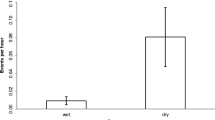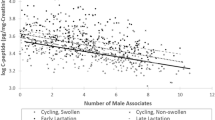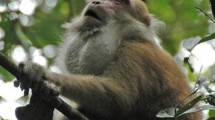Abstract
Aggression is rare among wild female chimpanzees. However, in the Kanyawara chimpanzee community in Kibale National Park, Uganda, stable use of food-rich core areas is linked to increased reproductive success, suggesting that contest competition might occur over access to the highest-quality ranges. To examine this hypothesis, we studied aggression and dominance relationships among Kanyawara females during a 10-yr period that included the immigration of 5 females into the community. We tested 2 predictions: 1) that female-female aggression should intensify when immigrants enter the community because this is when core area access is determined and 2) that the quality of core areas should reflect relative female dominance relationships. In support of the first prediction, female-female aggression increased 4-fold when new immigrants were in the community, with rates peaking when there were multiple immigrants. This pattern was due primarily to aggression by resident mothers toward immigrants and featured coalitionary aggression, a rare behavior among female chimpanzees. In support of the second prediction, females occupying core areas high in foraging quality ranked high overall and higher than expected for their ages, whereas females occupying low-quality core areas were lower-ranking and ranked lower than expected for their ages. Together, the data indicate that though female aggression does not regularly occur in chimpanzees, contest competition continues to play an important role in determining long-term access to resources, an important correlate of reproductive success.





Similar content being viewed by others
References
Altmann, J. (1974). Observational study of behavior: Sampling methods. Behaviour, 49, 227–267. doi:10.1163/156853974X00534.
Baker, K. C., & Smuts, B. B. (1994). Social relationships of female chimpanzees: Diversity between captive social groups. In R. W. Wrangham, W. C. McGrew, F. B. M. de Waal, & P. G. Heltne (Eds.), Chimpanzee Cultures (pp. 227–242). Cambridge, MA: Harvard University Press.
Boesch, C. (1996). Social grouping in Taï chimpanzees. In W. C. McGrew, L. F. Marchant, & T. Nishida (Eds.), Great Ape Societies (pp. 101–113). Cambridge, U.K.: Cambridge University Press.
Boesch, C., & Boesch-Achermann, H. (2000). The Chimpanzees of the Taï Forest: Behavioral ecology and evolution. Oxford: Oxford University Press.
Bygott, D. (1979). Agonistic behaviour and dominance in wild chimpanzees. In D. Hamburg, & E. R. McCown (Eds.), The Great Apes (pp. 405–427). Menlo Park, CA: Benjamin/Cummings.
Chapais, B. (1992). The role of alliances in social inheritance of rank among female primates. In A. H. Harcourt, & F. B. M. de Waal (Eds.), Coalitions and Alliances in Humans and Other Animals (pp. 29–59). Oxford: Oxford University Press.
Chapman, C. A., & Wrangham, R. W. (1993). Range use of the forest chimpanzees of Kibale: Implications for the understanding of chimpanzee social organization. American Journal of Primatology, 31, 263–273. doi:10.1002/ajp.1350310403.
Ellis, L. (1995). Dominance and reproductive success among nonhuman animals: A cross-species comparison. Ethology and Sociobiology, 16, 257–333. doi:10.1016/0162-3095(95)00050-U.
Emery Thompson, M. (2005). Reproductive endocrinology of wild chimpanzees (Pan troglodytes schweinfurthii): Methodological considerations and the role of hormones in sex and conception. American Journal of Primatology, 67, 137–158. doi:10.1002/ajp.20174.
Emery Thompson, M., Kahlenberg, S. M., Gilby, I. C., & Wrangham, R. W. (2007). Core area quality is associated with variance in reproductive success among female chimpanzees at Kibale National Park. Animal Behaviour, 73, 501–512. doi:10.1016/j.anbehav.2006.09.007.
Emery Thompson, M., Newton-Fisher, N. E., & Reynolds, V. (2006). Probable community transfer of parous adult female chimpanzees in the Budongo Forest, Uganda. International Journal of Primatology, 27, 1601–1617. doi:10.1007/s10764-006-9098-0.
Emery Thompson, M., & Wrangham, R. W. (2006). Comparison of sex differences in gregariousness in fission-fusion species: Reducing bias by standardizing for party size. In N. E. Newton-Fisher, H. Notman, V. Reynolds, & J. Paterson (Eds.), Primates of Western Uganda (pp. 209–226). New York: Springer.
Emery Thompson, M., & Wrangham, R. W. (2008). Diet and reproductive function in wild female chimpanzees (Pan troglodytes schweinfurthii) at Kibale National Park, Uganda. American Journal of Physical Anthropology, 135, 171–181.
Fawcett, K. A. (2000). Female Relationships and Food Availability in a Forest Community of Chimpanzees. Ph.D. thesis, University of Edinburgh.
Goodall, J. (1986). The chimpanzees of Gombe: Patterns of behavior. Cambridge, MA: Harvard University Press.
Greengrass, E. (2005). Sociability and dominance among female chimpanzees at Gombe. Ph.D. dissertation. University of Bristol, Bristol, U.K.
Harcourt, A. H. (1987). Dominance and fertility among female primates. Journal of Zoology, 213, 471–487.
Hasegawa, T. (1990). Sex differences in ranging patterns. In T. Nishida (Ed.), The chimpanzees of the Mahale Mountains (pp. 99–114). Tokyo: University of Tokyo Press.
Jameson, K. A., Appleby, M. C., & Freeman, L. C. (1999). Finding an appropriate order for a hierarchy based on probabilistic dominance. Animal Behaviour, 57, 991–998. doi:10.1006/anbe.1998.1077.
Kahlenberg, S. M. (2006). Female-female competition and male sexual coercion in Kanyawara chimpanzees. Ph.D. thesis. Harvard University, Cambridge, MA.
Kahlenberg, S. M., Emery Thompson, M., Muller, M. N., & Wrangham, R. W. (in press). Immigration costs for female chimpanzees and male protection as an immigrant counterstrategy to intrasexual aggression. Animal Behaviour.
Knott, C. D. (2001). Female reproductive ecology of the apes: Implications for human evolution. In P. T. Ellison (Ed.), Reproductive ecology and human evolution (pp. 429–463). New York: Aldine de Gruyter.
Koenig, A. (2002). Competition for resources and its behavioral consequences among female primates. International Journal of Primatology, 23, 759–783. doi:10.1023/A:1015524931226.
Lehmann, J., & Boesch, C. (2005). Bisexually bonded ranging in chimpanzees (Pan troglodytes verus). Behavioral Ecology and Sociobiology, 57, 525–535. doi:10.1007/s00265-004-0891-5.
Mitani, J. C., Watts, D. P., & Lwanga, J. S. (2002). Ecological and social correlates of chimpanzee party size and composition. In C. Boesch, G. Hohmann, & L. Marchant (Eds.), Behavioural Diversity in Chimpanzees and Bonobos (pp. 102–111). Cambridge, U.K.: Cambridge University Press.
Muller, M. N. (2002). Agonistic relations among Kanyawara chimpanzees. In C. Boesch, G. Hohmann, & L. Marchant (Eds.), Behavioural diversity in chimpanzees and bonobos (pp. 112–124). Cambridge, U.K.: Cambridge University Press.
Muller, M. N. (2007). Chimpanzee violence: Femmes fatales. Current Biology, 17, R365–R366. doi:10.1016/j.cub.2007.03.037.
Muller, M. N., Emery Thompson, M., & Wrangham, R. W. (2006). Chimpanzee males prefer mating with old females. Current Biology, 16, 2234–2238. doi:10.1016/j.cub.2006.09.042.
Muller, M. N., Kahlenberg, S. M., Emery Thompson, M., & Wrangham, R. W. (2007). Male coercion and costs of promiscuous mating for female chimpanzees. Proceedings of the Royal Society of London, Series B, 274, 1009–1014.
Mundry, R., & Fischer, J. (1998). Use of statistical programs for nonparametric tests of small samples often lead to incorrect P values: Examples from Animal Behaviour. Animal Behaviour, 56, 256–259. doi:10.1006/anbe.1998.0756.
Murray, C. M. (2007). A method for assigning categorical rank in female chimpanzees (Pan troglodytes schweinfurthii) via the frequency of approaches. International Journal of Primatology, 28, 853–864. doi:10.1007/s10764-007-9164-2.
Murray, C. M., Eberly, L. E., & Pusey, A. E. (2006). Foraging strategies as a function of season and rank among wild female chimpanzees (Pan troglodytes). Behavioral Ecology, 17, 1020–1028. doi:10.1093/beheco/arl042.
Murray, C. M., Mane, S. V., & Pusey, A. E. (2007). Dominance rank influences female space use in wild chimpanzees (Pan troglodytes): Towards an ideal despotic distribution. Animal Behaviour, 74, 1795–1804.
Newton-Fisher, N. E. (2004). Hierarchy and social status in Budongo chimpanzees. Primates, 45, 81–87. doi:10.1007/s10329-003-0064-6.
Nishida, T. (1989). Social interactions between resident and immigrant female chimpanzees. In P. G. Heltne, & L. A. Marquardt (Eds.), Understanding Chimpanzees (pp. 68–89). Cambridge, MA: Harvard University Press.
Nishida, T., Hiraiwa-Hasegawa, M., Hasegawa, T., & Takahata, Y. (1985). Group extinction and female transfer in wild chimpanzees in the Mahale National Park, Tanzania. Zeitschrift fur Tierpsychologie, 67, 284–301.
Pepper, J., Mitani, J. C., & Watts, D. P. (1999). General gregariousness and specific social preferences among wild chimpanzees. International Journal of Primatology, 20, 613–632.
Pusey, A. E. (1980). Inbreeding avoidance in chimpanzees. Animal Behaviour, 28, 543–552.
Pusey, A. E. (1990). Behavioural changes at adolescence in chimpanzees. Behaviour, 115, 203–246.
Pusey, A. E., Murray, C., Wallauer, W., Wilson, M., Wroblewski, E., & Goodall, J. (2008). Severe aggression among female Pan troglodytes schweinfurthii at Gombe National Park, Tanzania. International Journal of Primatology, 29, this issue doi:10.1007/s10764-008-9281-6.
Pusey, A. E., Oehlert, G. W., Williams, J. M., & Goodall, J. (2005). Influence of ecological and social factors on body mass of wild chimpanzees. International Journal of Primatology, 26, 3–31.
Pusey, A. E., & Packer, C. (1987). Dispersal and philopatry. In B. B. Smuts, D. L. Cheney, R. M. Seyfarth, R. W. Wrangham, & T. T. Struhsaker (Eds.), Primate societies (pp. 250–266). Chicago: Chicago University Press.
Pusey, A. E., Williams, J. M., & Goodall, J. (1997). The influence of dominance rank on the reproductive success of female chimpanzees. Science, 277, 828–831.
Sherry, D. S. (2002). Reproductive seasonality in chimpanzees and humans: Ultimate and proximate factors. Ph.D. thesis. Harvard University, Cambridge, MA.
Skorupa, J. P. (1988). The effects of selective timber harvesting on rain-forest primates in Kibale Forest, Uganda. Ph.D. thesis. University of California, Davis.
Sterck, E. H. M., Watts, D. P., & van Schaik, C. P. (1997). The evolution of female social relationships in nonhuman primates. Behavioral Ecology and Sociobiology, 41, 291–309.
Stumpf, R. (2007). Chimpanzees and bonobos: Diversity within and between species. In C. J. Campbell, A. Fuentes, K. C. Mackinnon, M. Panger, & S. K. Bearder (Eds.), Primates in perspective (pp. 321–344). Oxford: Oxford University Press.
Townsend, S. W., Slocombe, K. E., Emery Thompson, M., & Zuberbühler, K. (2007). Female-led infanticide in wild chimpanzees. Current Biology, 17, 355–356.
van Schaik, C. P. (1989). The ecology of social relationships amongst female primates. In R. A. Foley, & V. Standen (Eds.), Comparative socioecology (pp. 195–218). Oxford: Blackwell.
Williams, J. M. (2000). Female strategies and reasons for territoriality in chimpanzees: Lessons from three decades of research at Gombe. Ph.D. thesis, University of Minnesota.
Williams, J. M., Liu, H.-Y., & Pusey, A. E. (2002a). Costs and benefits of grouping for female chimpanzees at Gombe. In C. Boesch, G. Hohmann, & L. Marchant (Eds.), Behavioural diversity in chimpanzees and bonobos (pp. 192–203). Cambridge, U.K.: Cambridge University Press.
Williams, J. M., Oehlert, G. W., Carlis, J. V., & Pusey, A. E. (2004). Why do male chimpanzees defend a group range? Animal Behavior, 68, 523–532.
Williams, J. M., Pusey, A. E., Carlis, J. V., Farm, B. P., & Goodall, J. (2002b). Female competition and male territorial behaviour influence female chimpanzees’ ranging patterns. Animal Behaviour, 63, 347–360.
Wilson, M. L. (2001). Imbalances of power: How chimpanzees respond to the threat of intergroup aggression. Ph.D. thesis. Harvard University, Cambridge, MA.
Wilson, M. L., & Wrangham, R. W. (2003). Intergroup relations in chimpanzees. Annual Review of Anthropology, 32, 363–392.
Wittig, R. M., & Boesch, C. (2003). Food competition and linear dominance hierarchy among female chimpanzees of the Taї National Park. International Journal of Primatology, 24, 847–867.
Wrangham, R. W. (1979). Sex differences in chimpanzee dispersion. In D. Hamburg, & E. R. McCown (Eds.), The great apes (pp. 480–489). Menlo Park, CA: Benjamin/Cummings.
Wrangham, R. W. (1980). An ecological model of female-bonded primate groups. Behaviour, 75, 262–300.
Wrangham, R. W. (2000). Why are male chimpanzees more gregarious than mothers? A scramble competition hypothesis. In P. M. Kappeler (Ed.), Primate males: Causes and consequences of variation in group composition (pp. 248–258). Cambridge, U.K.: Cambridge University Press.
Wrangham, R. W., Chapman, C. A., Clark-Arcadi, A. P., & Isabirye-Basuta, G. (1996). Social ecology of Kanyawara chimpanzees: Implications for understanding the costs of great ape groups. In W. C. McGrew, L. F. Marchant, & T. Nishida (Eds.), Great ape societies (pp. 45–57). Cambridge, U.K.: Cambridge University Press.
Wrangham, R. W., Clark, A. P., & Isabirye-Basuta, G. (1992). Female social relationships and social organization of Kibale Forest chimpanzees. In T. Nishida, W. C. McGrew, P. Marler, M. Pickford, & F. B. M. de Waal (Eds.), Topics in primatology, vol. I: Human origins (pp. 81–98). Tokyo: University of Tokyo Press.
Wrangham, R. W., & Smuts, B. B. (1980). Sex differences in the behavioural ecology of chimpanzees in the Gombe National Park, Tanzania. Journal of Reproduction and Fertility (Supplement), 28, 13–31.
Acknowledgments
We thank Anne Pusey and Carson Murray for organizing the 2006 IPS symposium on female competition in great apes and for inviting us to participate. The U.S. National Science Foundation (grant no. 0416125), the L.S.B. Leakey Foundation, the National Geographic Society, and the Wenner-Gren Foundation generously funded research at Kanyawara. The Uganda Wildlife Authority, Uganda National Council of Science and Technology, and Makerere University Biological Field Station granted research permission. We thank G. Isabirye-Basuta and J. Kasenene for their support. The late J. Barwogeza, J. Sunday, C. Katongole, J. Kyomuhando, F. Mugurusi, the late D. Muhangyi, the late C. Muruuli, S. Musana, J. Musunguzi, D. Sebugwawo, and P. Tuhairwe collected data, with research oversight by K. Duffy, C. Hooven, A. Houle, M. Muller, E. Otali, K. Pieta, and M. Wilson. Comments from 2 anonymous reviewers improved the article.
Author information
Authors and Affiliations
Corresponding author
Rights and permissions
About this article
Cite this article
Kahlenberg, S.M., Emery Thompson, M. & Wrangham, R.W. Female Competition over Core Areas in Pan troglodytes schweinfurthii, Kibale National Park, Uganda. Int J Primatol 29, 931–947 (2008). https://doi.org/10.1007/s10764-008-9276-3
Received:
Accepted:
Published:
Issue Date:
DOI: https://doi.org/10.1007/s10764-008-9276-3




